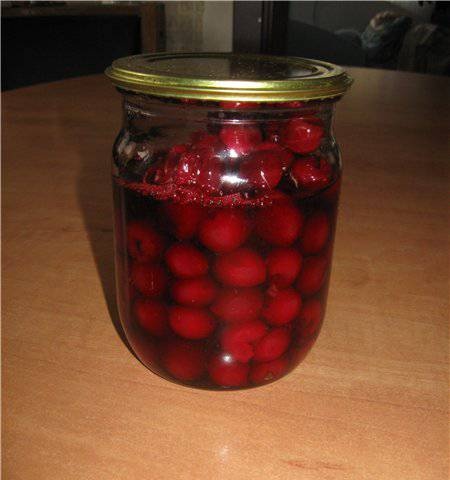|
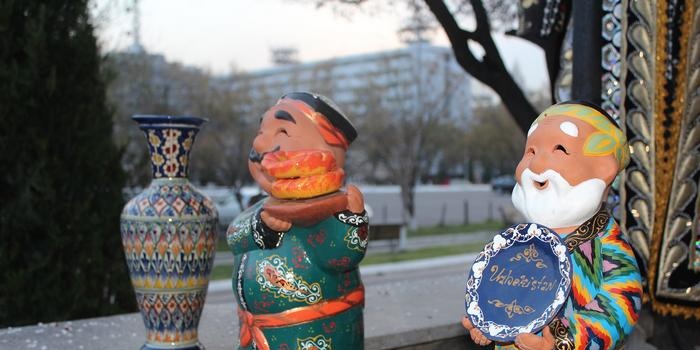 Who doesn't love new cookware? In the everyday life of the peoples of Uzbekistan and Central Asia, the acquisition of new dishes is a whole custom, even a condition, for example, a wedding ceremony. When a girl is given in marriage, her relatives bring a different gift a day or two before the wedding ceramic dishes: half a dozen bowls, cups, a couple of dishes for pilaf, two or three teapots. Of course, the dishes should be not only comfortable, but also, like clothes or music, beautiful, so that the holiday of the soul is imprinted for a long time. Who doesn't love new cookware? In the everyday life of the peoples of Uzbekistan and Central Asia, the acquisition of new dishes is a whole custom, even a condition, for example, a wedding ceremony. When a girl is given in marriage, her relatives bring a different gift a day or two before the wedding ceramic dishes: half a dozen bowls, cups, a couple of dishes for pilaf, two or three teapots. Of course, the dishes should be not only comfortable, but also, like clothes or music, beautiful, so that the holiday of the soul is imprinted for a long time.
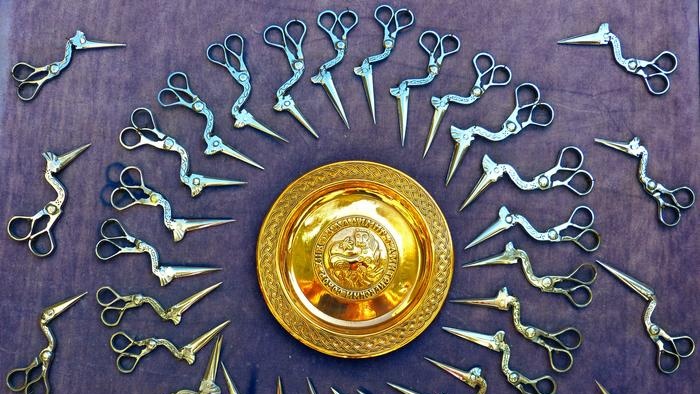 Making beautiful dishes is a big responsibility. Usually a few craftsmen who know the secrets of making ceramics take up the work. And their roots go back to immemorial antiquity. As before, a modern folk master works on the potter's wheel, shaping the vessels, drying them, grinds them, then dries them again, strengthens them with special clay and only after finishing painting them. The most interesting work, of course, is painting. What is the ornament? Style? Patterns? Different regions of Uzbekistan have their own style, it has evolved over the centuries, although the artistic principles are the same, national. For example, Bukhara and Gijduvan are not like Samarkand, but the ceramics of Tashkent, Shakhrisabz, etc., differ from all of them. Making beautiful dishes is a big responsibility. Usually a few craftsmen who know the secrets of making ceramics take up the work. And their roots go back to immemorial antiquity. As before, a modern folk master works on the potter's wheel, shaping the vessels, drying them, grinds them, then dries them again, strengthens them with special clay and only after finishing painting them. The most interesting work, of course, is painting. What is the ornament? Style? Patterns? Different regions of Uzbekistan have their own style, it has evolved over the centuries, although the artistic principles are the same, national. For example, Bukhara and Gijduvan are not like Samarkand, but the ceramics of Tashkent, Shakhrisabz, etc., differ from all of them.
 The traditions of Tashkent ceramics are recent, they developed from the most diverse trends at the turn of the past and our centuries. And yet, in character, it is close to the mass green-yellow ceramics of the Zeravshan Valley, and with its own specific method of double coating dishes: first with red glaze, and then white. This white background is scratched to the red base of the pattern, and the dish begins to play, live. The traditions of Tashkent ceramics are recent, they developed from the most diverse trends at the turn of the past and our centuries. And yet, in character, it is close to the mass green-yellow ceramics of the Zeravshan Valley, and with its own specific method of double coating dishes: first with red glaze, and then white. This white background is scratched to the red base of the pattern, and the dish begins to play, live.
 The traditional dishes of Tashkent ceramics, decorated with red roses on bright green stems, were extremely cheerful. Usually, both the branches of roses and the stems fit well on the rather sheer outer side of the white bowl. Colored ornament is widespread on many ceramic items. Dishes with so-called circular compositions are noteworthy. The centric intersection of eight circles in front of our eyes is built into various shapes of geometrically even oval-petals. These circular rosettes have a double outline. They clearly stand out against the background, covered with bright streaks of yellow-green and brown glaze and filled with small ornamental figures resembling carved cotton leaves, and smaller ones - sunflower flowers. The traditional dishes of Tashkent ceramics, decorated with red roses on bright green stems, were extremely cheerful. Usually, both the branches of roses and the stems fit well on the rather sheer outer side of the white bowl. Colored ornament is widespread on many ceramic items. Dishes with so-called circular compositions are noteworthy. The centric intersection of eight circles in front of our eyes is built into various shapes of geometrically even oval-petals. These circular rosettes have a double outline. They clearly stand out against the background, covered with bright streaks of yellow-green and brown glaze and filled with small ornamental figures resembling carved cotton leaves, and smaller ones - sunflower flowers.
 If we imagine that cities have color, then gray-yellow-brown prevails in the color of Bukhara. This is explained by countless adobe buildings and gray-brown tones of ancient monuments. In summer, the city is flooded with a merciless sun and dusty with dust blown by the winds from the neighboring desert. Perhaps that is why the juicy green color is especially pleasing to the eye in Bukhara. It is not for nothing that dishes covered with shiny green glaze are immediately striking at the bazaar. Free drips of glaze either thicken with emerald-dark greens, then lie in a thin layer, translucent with the bright light green color of spring grass. The picturesque play of green glaze is set off by a usually uncomplicated ornament: two or three wavy lines along the edge of the dish, a wavy circle or a simple rosette in the center. Vessels with a green, and sometimes with a yellow-green spotted color have been found in Bukhara (made in Gijduvan) since ancient times, starting from the 9th century. If we imagine that cities have color, then gray-yellow-brown prevails in the color of Bukhara. This is explained by countless adobe buildings and gray-brown tones of ancient monuments. In summer, the city is flooded with a merciless sun and dusty with dust blown by the winds from the neighboring desert. Perhaps that is why the juicy green color is especially pleasing to the eye in Bukhara. It is not for nothing that dishes covered with shiny green glaze are immediately striking at the bazaar. Free drips of glaze either thicken with emerald-dark greens, then lie in a thin layer, translucent with the bright light green color of spring grass. The picturesque play of green glaze is set off by a usually uncomplicated ornament: two or three wavy lines along the edge of the dish, a wavy circle or a simple rosette in the center. Vessels with a green, and sometimes with a yellow-green spotted color have been found in Bukhara (made in Gijduvan) since ancient times, starting from the 9th century.
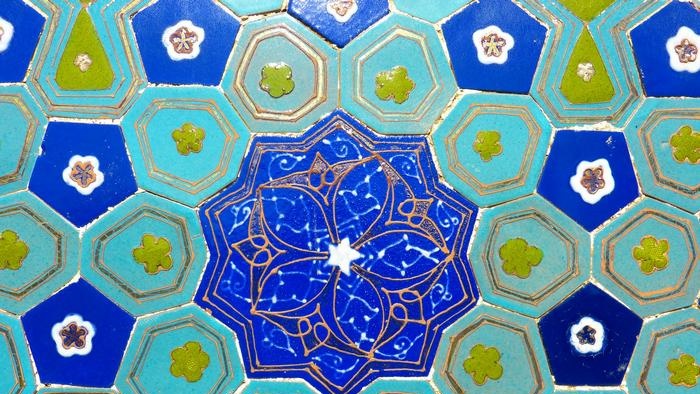 The ceramics of the south of Uzbekistan have a different character, in the painting of which the southern heat itself is felt. The center of folk craft is the city of Shakhrisabz, which means the city of greenery. The ceramics of Shakhrisabz are red-red, burning, partly due to the ferruginous clays mined in the mountains nearby.How is the color scheme of the local ceramics built? The master applies a red spot, next to a honey-yellow one, then again a red stripe, then a narrow brown edging, again a red spot, and next to a meager dose of cold white - the whole colorful range is deliberately built so as to thicken the effect of the main reddish tone and so that the dish burns, like the hot midday sun. The ceramics of the south of Uzbekistan have a different character, in the painting of which the southern heat itself is felt. The center of folk craft is the city of Shakhrisabz, which means the city of greenery. The ceramics of Shakhrisabz are red-red, burning, partly due to the ferruginous clays mined in the mountains nearby.How is the color scheme of the local ceramics built? The master applies a red spot, next to a honey-yellow one, then again a red stripe, then a narrow brown edging, again a red spot, and next to a meager dose of cold white - the whole colorful range is deliberately built so as to thicken the effect of the main reddish tone and so that the dish burns, like the hot midday sun.
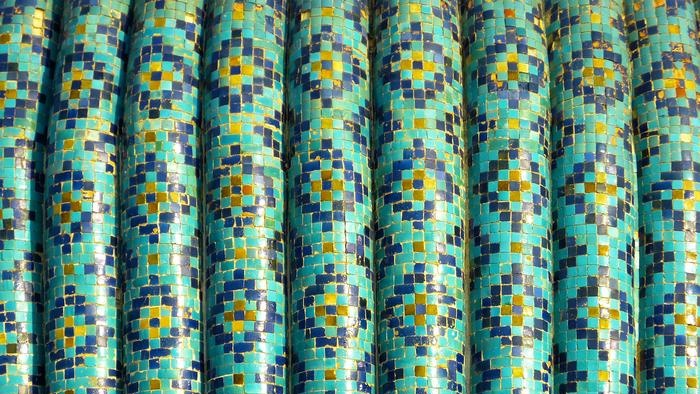 The pattern of Shakhrisabz ceramics has long been established, it is formed by three or four elements, the motive called "bull's eye" is often used - this is when each circle consists of a red-red center and a yellow or brown rim. Sometimes two such circles are combined with two tulips, sometimes with flowers resembling chamomile. The pattern of Shakhrisabz ceramics has long been established, it is formed by three or four elements, the motive called "bull's eye" is often used - this is when each circle consists of a red-red center and a yellow or brown rim. Sometimes two such circles are combined with two tulips, sometimes with flowers resembling chamomile.
Ceramics of Khorezm cities - blue, turquoise and white tones, it is associated with architecture, all decorative and applied arts.
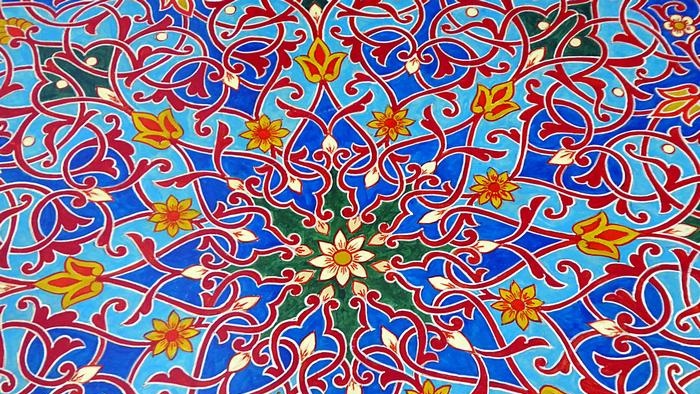 Usually, glazed Khorezm dishes have the same color combinations, the same style of painting as on the majolica of Khiva buildings, the same ornamental motifs and patterns as on wooden, carved doors and columns of buildings. Khorezm bowls, sparkling with the play of blue, blue, white patterns, sometimes resemble the domes of mausoleums, lined with patterned blue-blue majolica. Khorezm is the only region in Uzbekistan where flat dishes are not made. Both dishes and bowls are replaced by a badia - an in-depth dish on a round flat stand. Badia serves as both a dish, a bowl and a vase. Usually, glazed Khorezm dishes have the same color combinations, the same style of painting as on the majolica of Khiva buildings, the same ornamental motifs and patterns as on wooden, carved doors and columns of buildings. Khorezm bowls, sparkling with the play of blue, blue, white patterns, sometimes resemble the domes of mausoleums, lined with patterned blue-blue majolica. Khorezm is the only region in Uzbekistan where flat dishes are not made. Both dishes and bowls are replaced by a badia - an in-depth dish on a round flat stand. Badia serves as both a dish, a bowl and a vase.
There is no splendor in the ceramics of Khorezm, no "excesses". All elements are laconic and strictly justified, the figures of the pattern have been verified for centuries; studded with small details, they create a striking richness of ornamental rhythms.
P. Redkin
|
 Who doesn't love new cookware? In the everyday life of the peoples of Uzbekistan and Central Asia, the acquisition of new dishes is a whole custom, even a condition, for example, a wedding ceremony. When a girl is given in marriage, her relatives bring a different gift a day or two before the wedding
Who doesn't love new cookware? In the everyday life of the peoples of Uzbekistan and Central Asia, the acquisition of new dishes is a whole custom, even a condition, for example, a wedding ceremony. When a girl is given in marriage, her relatives bring a different gift a day or two before the wedding  Making beautiful dishes is a big responsibility. Usually a few craftsmen who know the secrets of making ceramics take up the work. And their roots go back to immemorial antiquity. As before, a modern folk master works on the potter's wheel, shaping the vessels, drying them, grinds them, then dries them again, strengthens them with special clay and only after finishing painting them. The most interesting work, of course, is painting. What is the ornament? Style? Patterns? Different regions of Uzbekistan have their own style, it has evolved over the centuries, although the artistic principles are the same, national. For example, Bukhara and Gijduvan are not like Samarkand, but the ceramics of Tashkent, Shakhrisabz, etc., differ from all of them.
Making beautiful dishes is a big responsibility. Usually a few craftsmen who know the secrets of making ceramics take up the work. And their roots go back to immemorial antiquity. As before, a modern folk master works on the potter's wheel, shaping the vessels, drying them, grinds them, then dries them again, strengthens them with special clay and only after finishing painting them. The most interesting work, of course, is painting. What is the ornament? Style? Patterns? Different regions of Uzbekistan have their own style, it has evolved over the centuries, although the artistic principles are the same, national. For example, Bukhara and Gijduvan are not like Samarkand, but the ceramics of Tashkent, Shakhrisabz, etc., differ from all of them. The traditions of Tashkent ceramics are recent, they developed from the most diverse trends at the turn of the past and our centuries. And yet, in character, it is close to the mass green-yellow ceramics of the Zeravshan Valley, and with its own specific method of double coating dishes: first with red glaze, and then white. This white background is scratched to the red base of the pattern, and the dish begins to play, live.
The traditions of Tashkent ceramics are recent, they developed from the most diverse trends at the turn of the past and our centuries. And yet, in character, it is close to the mass green-yellow ceramics of the Zeravshan Valley, and with its own specific method of double coating dishes: first with red glaze, and then white. This white background is scratched to the red base of the pattern, and the dish begins to play, live. The traditional dishes of Tashkent ceramics, decorated with red roses on bright green stems, were extremely cheerful. Usually, both the branches of roses and the stems fit well on the rather sheer outer side of the white bowl. Colored ornament is widespread on many ceramic items. Dishes with so-called circular compositions are noteworthy. The centric intersection of eight circles in front of our eyes is built into various shapes of geometrically even oval-petals. These circular rosettes have a double outline. They clearly stand out against the background, covered with bright streaks of yellow-green and brown glaze and filled with small ornamental figures resembling carved cotton leaves, and smaller ones - sunflower flowers.
The traditional dishes of Tashkent ceramics, decorated with red roses on bright green stems, were extremely cheerful. Usually, both the branches of roses and the stems fit well on the rather sheer outer side of the white bowl. Colored ornament is widespread on many ceramic items. Dishes with so-called circular compositions are noteworthy. The centric intersection of eight circles in front of our eyes is built into various shapes of geometrically even oval-petals. These circular rosettes have a double outline. They clearly stand out against the background, covered with bright streaks of yellow-green and brown glaze and filled with small ornamental figures resembling carved cotton leaves, and smaller ones - sunflower flowers. If we imagine that cities have color, then gray-yellow-brown prevails in the color of Bukhara. This is explained by countless adobe buildings and gray-brown tones of ancient monuments. In summer, the city is flooded with a merciless sun and dusty with dust blown by the winds from the neighboring desert. Perhaps that is why the juicy green color is especially pleasing to the eye in Bukhara. It is not for nothing that dishes covered with shiny green glaze are immediately striking at the bazaar. Free drips of glaze either thicken with emerald-dark greens, then lie in a thin layer, translucent with the bright light green color of spring grass. The picturesque play of green glaze is set off by a usually uncomplicated ornament: two or three wavy lines along the edge of the dish, a wavy circle or a simple rosette in the center. Vessels with a green, and sometimes with a yellow-green spotted color have been found in Bukhara (made in Gijduvan) since ancient times, starting from the 9th century.
If we imagine that cities have color, then gray-yellow-brown prevails in the color of Bukhara. This is explained by countless adobe buildings and gray-brown tones of ancient monuments. In summer, the city is flooded with a merciless sun and dusty with dust blown by the winds from the neighboring desert. Perhaps that is why the juicy green color is especially pleasing to the eye in Bukhara. It is not for nothing that dishes covered with shiny green glaze are immediately striking at the bazaar. Free drips of glaze either thicken with emerald-dark greens, then lie in a thin layer, translucent with the bright light green color of spring grass. The picturesque play of green glaze is set off by a usually uncomplicated ornament: two or three wavy lines along the edge of the dish, a wavy circle or a simple rosette in the center. Vessels with a green, and sometimes with a yellow-green spotted color have been found in Bukhara (made in Gijduvan) since ancient times, starting from the 9th century. The ceramics of the south of Uzbekistan have a different character, in the painting of which the southern heat itself is felt. The center of folk craft is the city of Shakhrisabz, which means the city of greenery. The ceramics of Shakhrisabz are red-red, burning, partly due to the ferruginous clays mined in the mountains nearby.How is the color scheme of the local ceramics built? The master applies a red spot, next to a honey-yellow one, then again a red stripe, then a narrow brown edging, again a red spot, and next to a meager dose of cold white - the whole colorful range is deliberately built so as to thicken the effect of the main reddish tone and so that the dish burns, like the hot midday sun.
The ceramics of the south of Uzbekistan have a different character, in the painting of which the southern heat itself is felt. The center of folk craft is the city of Shakhrisabz, which means the city of greenery. The ceramics of Shakhrisabz are red-red, burning, partly due to the ferruginous clays mined in the mountains nearby.How is the color scheme of the local ceramics built? The master applies a red spot, next to a honey-yellow one, then again a red stripe, then a narrow brown edging, again a red spot, and next to a meager dose of cold white - the whole colorful range is deliberately built so as to thicken the effect of the main reddish tone and so that the dish burns, like the hot midday sun. The pattern of Shakhrisabz ceramics has long been established, it is formed by three or four elements, the motive called "bull's eye" is often used - this is when each circle consists of a red-red center and a yellow or brown rim. Sometimes two such circles are combined with two tulips, sometimes with flowers resembling chamomile.
The pattern of Shakhrisabz ceramics has long been established, it is formed by three or four elements, the motive called "bull's eye" is often used - this is when each circle consists of a red-red center and a yellow or brown rim. Sometimes two such circles are combined with two tulips, sometimes with flowers resembling chamomile. Usually, glazed Khorezm dishes have the same color combinations, the same style of painting as on the majolica of Khiva buildings, the same ornamental motifs and patterns as on wooden, carved doors and columns of buildings. Khorezm bowls, sparkling with the play of blue, blue, white patterns, sometimes resemble the domes of mausoleums, lined with patterned blue-blue majolica. Khorezm is the only region in Uzbekistan where flat dishes are not made. Both dishes and bowls are replaced by a badia - an in-depth dish on a round flat stand. Badia serves as both a dish, a bowl and a vase.
Usually, glazed Khorezm dishes have the same color combinations, the same style of painting as on the majolica of Khiva buildings, the same ornamental motifs and patterns as on wooden, carved doors and columns of buildings. Khorezm bowls, sparkling with the play of blue, blue, white patterns, sometimes resemble the domes of mausoleums, lined with patterned blue-blue majolica. Khorezm is the only region in Uzbekistan where flat dishes are not made. Both dishes and bowls are replaced by a badia - an in-depth dish on a round flat stand. Badia serves as both a dish, a bowl and a vase.







